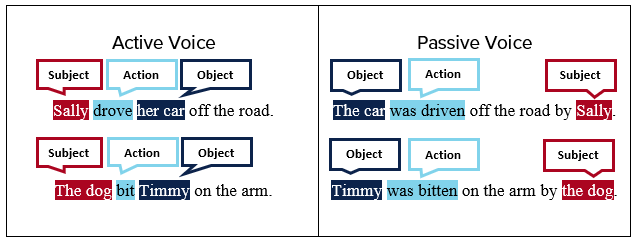Should copywriters ever use passive voice?
In copywriting, the use of active voice is generally considered more effective than passive voice. This is because active voice puts the focus on the subject and the action it is taking, making the copy more direct and engaging.
However, there are times when using passive voice can be appropriate and even preferred in certain situations.

Passive voice vs. Active voice
In active voice, the subject of the sentence is the one performing the action. For example: “The cat chased the mouse.” In this sentence, the subject “cat” is performing the action “chased.”
In passive voice, the subject of the sentence is being acted upon. For example: “The mouse was chased by the cat.” In this sentence, the subject “mouse” is being acted upon by the cat.

Why passive voice is often considered less effective
Passive voice can make copy feel less direct and engaging, as the focus is on the object rather than the subject. It can also make the copy feel less personal and less active, which can be less compelling for readers. In addition, passive voice often requires more words to convey the same meaning, which can make the copy less concise and harder to read.
When to use passive voice
Despite its drawbacks, there are times when using passive voice can be appropriate. Here are a few situations when passive voice may be preferred:
- When the subject is unknown or unimportant: If the subject of the sentence is unknown or unimportant, using passive voice can be a useful way to convey the information without having to specify a subject. For example: “The window was broken” rather than “Someone broke the window.”
- When the focus is on the object: In some cases, the object of the sentence may be more important or relevant than the subject. In these situations, using passive voice can help put the focus on the object and make the copy more impactful. For example: “The cake was eaten” rather than “She ate the cake.”
- When the action is more important than the subject: In some cases, the action itself may be more important than the subject performing the action. In these situations, using passive voice can help emphasize the action and make the copy more compelling. For example: “The car was washed” rather than “He washed the car.”
It’s important to note that passive voice should be used sparingly and only when it serves a specific purpose.
In most cases, active voice is a better option for creating engaging and effective copy.
Conclusion
While active voice is generally preferred in copywriting, there are times when using passive voice can be appropriate.
It’s important to consider the specific needs and goals of the copy and choose the voice that best communicates the desired message.
As with any aspect of copywriting, it’s important to use passive voice sparingly and only when it serves a specific purpose. In most cases, active voice is a more effective and engaging option.

Need someone who knows how to use copywriting best practices? 😉 Get in touch with me.
